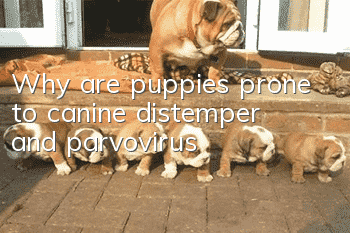How do dogs become infected with canine distemper? Can late-stage canine distemper be treated with monoclonal antibody injections?

Nowadays, many people like to keep pet dogs. Dogs live indoors for a long time, lack sunlight and exercise, and have reduced immunity, so they are easily infected with diseases. Canine distemper is a highly transmissible disease among dogs. Once infected with canine distemper, the mortality rate reaches more than 80%.
Central nervous system (CNS) infection is the most serious complication of canine distemper, leading to various neurological diseases and often with poor prognosis. Frequently, neurological symptoms occur in the absence of systemic signs and are associated with demyelinating lesions. However, not all canine distemper cases will show neurological symptoms, and there are certain strain differences. For example, the R252 and A75-17 strains currently discovered mainly cause demyelinating leukoencephalitis, and Snyder Hill mainly causes acute poliomyelitis.
On the one hand, humoral immunity and cellular immunity are crucial in resisting canine distemper virus infection. The lack of effective humoral immunity in the early stage may be fatal. On the other hand, during the systemic immune response, the presence of antibodies and the deposition of immune complexes may promote virus spread in CNS endothelial cells. In the article, we introduce in detail how the virus infects the nervous system and the mechanism of demyelination.
01
Virus infection process
After viral infection, it first appears in the phagocytes of the host's upper respiratory tract, and then migrates to lymphatic and hematopoietic tissues (such as spleen, thymus, lymph nodes, bone marrow), resulting in lymphopenia and immunosuppression. The suppression of immunity is caused by secondary bacteria. Infection provides the basis. During viral infections, the absence or insufficiency of humoral immunity promotes secondary viremia, which leads to infection of epithelial cells, mesenchymal cells, and the central nervous system (CNS). Entering the chronic phase, the immune system gradually recovers.
Figure 1. The mechanism of immunosuppression caused by CDV infection: viral infection and the combination of viral N protein/CD32 lead to reduced antigen presentation and interfere with the maturation of dendritic cells and B cells, resulting in a significant reduction in the formation of plasma cells and immunoglobulin production. .
02
Virus invades the nervous system
Blood route: The virus infects monocytes → passes through the blood-brain barrier → infects the inherent epithelial and endothelial cells in the brain → spreads in the brain with the cerebrospinal fluid (CSF) → infects glial cells and neurons.
Other pathways: CDV infects neurons located in the olfactory mucosa → then the virus infects the olfactory glomerulus along the olfactory nerve fibers → is transmitted to deeper CNS institutions.
The virus recognizes and infects cells through cell receptors CD150 and PVRL4, but these cells are affected byExpression in the CNS is very limited. In infected oligodendrocytes, only CDV RNA and no CDV protein were detected, indicating that CDV is only transcribed but not translated in infected oligodendrocytes. This limited infection and the fact that viral genes are only transcribed but not translated also confirm the fact that the virus is not excreted in the late stage.
03
Mechanism of demyelinating lesions
After CDV infects the CNS, it induces activation of microglia → secretes toxin factors (TNF-α, oxygen free radicals) → inhibits the growth of oligodendrocytes and myelin sheaths, causing damage to oligodendrocytes and demyelinating lesions.
Figure 2. Myelin structure diagram
Myelin is a membrane surrounding the axons of nerve cells. There are three types of glial cells in the central nervous system (CNS): oligodendrocytes, astrocytes, and microglia, all involved in the formation of myelin. Among them, abnormal oligodendrocytes lead to demyelination lesions in the central nervous system, neuronal damage or psychiatric diseases; microglia are important immune cells in the CNS; astrocytes provide nutrients to nerve cells.
In addition, the bystander mechanism of the interaction between macrophages and antiviral antibodies is an important cause of chronic inflammatory demyelination. During the chronic period of viral infection, the immune response gradually recovers, CD4+ cells infiltrate around blood vessels, and then a large number of plasma cells are recruited, and intrathecal antibody synthesis is vigorous. After CDV antibodies in blood and cerebrospinal fluid bind to infected cells, they bind to Fc receptors on adjacent macrophages, inducing the release of a large amount of oxygen free radicals, causing damage to oligodendrocytes or myelin, leading to demyelination. lesions, causing neuronal damage or mental illness.
04
Causes of persistent canine distemper infection
Restricted infection by viruses: In oligodendrocytes, viral genes continue to replicate but do not express proteins, thus evading immune system recognition and causing new demyelination damage.
Non-cytolytic selective transmission: CDV spreads in a non-cytolytic form after infection, releasing very limited virus. In this way, CDV escapes immune surveillance.
Summary
Simply put, early demyelination is mediated by viruses, and late stage demyelination is mediated by a bystander mechanism involving antigens. After the immune system recovers in the late stage, humoral immunity is enhanced, and antiviral antibodies that bind to infected cells further bind to phagocytes. Damage to myelin causes neurological symptoms. Restricted infection with the virus greatly reduces viral protein expression and detectable antigen. Non-cytolytic transmission limits viral release, aiding diseaseThe virus escapes the host's immune mechanisms and persists.
Based on this characteristic of canine distemper infection, it is known that the prevention and protection of canine distemper provides dogs with good immune defense in the early stage of canine distemper infection, which is very important. However, when dogs are in the late stage of canine distemper, the presence of antibodies actually increases the damage to the nervous system. Therefore, it is not recommended to inject monoclonal antibody treatment in the late stage of canine distemper. Humoral immunity runs through the entire process of canine distemper infection. Tracking the development trend of the disease through antibody detection can help to formulate and change treatment plans in a timely manner.
References
1.Carvalho OV, Botelho CV, Ferreira CG, et al. Immunopathogenic and neurological mechanisms of canine distemper virus. Adv Virol. 2012;2012:163860.
2.Vandevelde M, Zurbriggen A. Demyelination in canine distemper virus infection: a review. Acta Neuropathologica. 2005;109(1):56–68.
3.Botteron C, Zurbriggen A, Griot C, et al. Canine distemper virus-immune complexes induce bystander degeneration of oligodendrocytes.[J]. Acta Neuropathologica, 1992, 83(4):402.
4.Rima B K, Duffy N, Mitchell W J, et al. Correlation between humoral immune responses and presence of virus in the CNS in dogs experimentally infected with canine distemper virus[J]. Archives of Virology, 1991, 121(1-4) :1.
5.Beineke A, Puff C, Seehusen F, et al. Pathogenesis and immunopathology of systemic and nervous canine distemper[J]. Veterinary Immunology & Immunopathology, 2009, 127(1-2):0-18.
6.Lempp C, Spitzbarth I, Puff C, et al. New aspects of the pathogenesis of canine distemper leukoencephalitis. Viruses. 2014;6(7):2571-601. Published 2014 Jul 2. doi:10.3390/v6072571
Here I would like to remind dog owners to pay attention to the health of their dogs, and prevention is better than cure. Don’t wait until your dog is sick before taking it seriously. When the disease reaches an advanced stage, treatment may not necessarily save your pet’s life.
- Dog's nose is dry and cracked
- How to prevent dental calculus in dogs
- Reasons why dog poop is not formed
- Dog Kennel Cough Symptoms and Treatment
- Can you feed your dog raw meat?
- Learn dog language and understand your dog - no need to guess your dog’s emotions
- Which small dog is docile and easy to raise?
- What fruits can and cannot be eaten by dogs? How should dogs eat fruit?
- Dogs cannot blindly supplement calcium. Is your dog’s calcium supplement correct?
- My puppy has purulent eye droppings and can’t open his eyes



